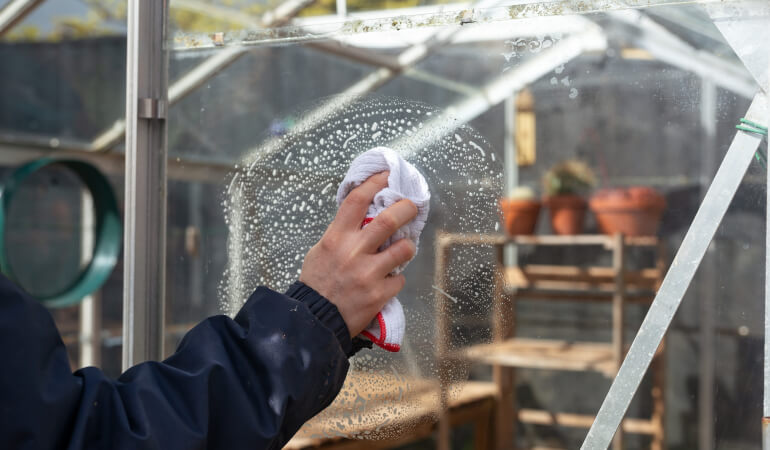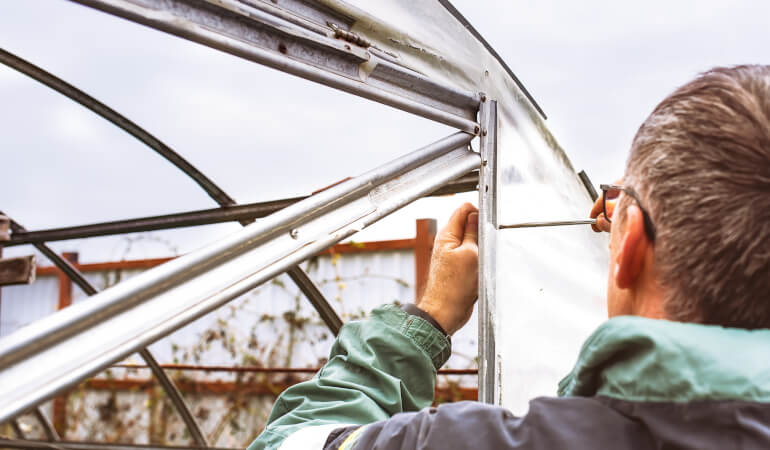With the arrival of autumn, many gardeners prepare to put their tools and gloves away in preparation for the long wait until spring. However, greenhouse owners are continuing to diligently tend to their plants in expectation of the harvest still to come.
If you happen to be one of them, then you probably already know too well all the jobs involved in proper greenhouse maintenance. Still, discovering a few more tips on when and how to easily clean your glasshouse, and deal with humidity and pests can only help.
And if you are just starting your greenhouse, then this guide will provide you with all the essential maintenance techniques you may need to enjoy a healthy produce.
Table of Contents
Thoroughly clean your greenhouse
As with all things in life, the amount of effort you put into starting and maintaining a project will directly affect the results. Greenhouses are not self-maintaining environments so, in order to keep plants healthy and achieve the best results possible, you will need to expend some effort to keep your planthouse in top condition. The best way to do that is by cleaning both inside and out. Here’s how…
Cleaning a greenhouse’s exterior
- Start by removing any debris from the area around your greenhouse and sweep away any fallen leaves or built-up dirt.
- Inspect the gutters to make sure there are no debris and piles of leaves blocking them. You can remove any collected dirt by hand. A steel wire or wire hanger can help solve a small clogging problem. If you cannot locate or access the clogged area, then a specialised gutter cleaning could help.
- Wash the outside glass with warm water, mild eco-friendly detergent and a sponge. If you don’t have a safe cleaning solution, you can always prepare a homemade glass cleaner by mixing warm water with white vinegar. To clean the roof of your greenhouse, use a mop or a sponge with an arm which can be extended. If you don’t have one, attach your sponge to a broom handle or bamboo cane.
- Clean beneath the window panel joints with a hose to remove any hidden dirt.
- Check and clean water butts, if you collect water in such. They could be harbouring algae, dangerous microorganisms and even mosquito eggs. You will have to get rid of any collected water in order to effectively scrub and wash them.
Cleaning your greenhouse on the inside
Now that the outside is all sparkly and clean, it is time to step into your greenhouse. This part is a little more involved, so have a cup of tea or coffee and a small break before starting.
- If you have any electrics in your greenhouse, switch them all off and disconnect them from the mains, if possible.
- Organise all of the empty plant pots and grow bags into ones you will keep and ones you will throw away.
- Remove the equipment you will keep, all plants (wherever possible), and all shelving units. If it is winter, move any sensitive plants to a shed, a conservatory, or someplace sheltered.
- Use a broom to brush the interior walls and ceiling to remove dirt and cobwebs.
- Follow this by sweeping the floor of your greenhouse to remove fallen leaves, dirt, spilt soil and any other debris that has accumulated.
- Clean every surface on the inside of your greenhouse with warm water, a safe disinfectant, such as a hydrogen peroxide, and a sponge.
- Wash all shelving units with warm water and disinfectant before moving them back inside.
- Disinfect all empty plant pots, containers and tools you use.
When is the best time to clean your greenhouse?
Generally, the most suitable time to clean your greenhouse is during winter or at the start of spring, but choosing the right time also depends on what you are growing. If you focus on growing summer plants, such as peppers, then clean in the winter. But, if you grow more specialised plants throughout the year, then the best time to clean is in the middle of autumn.
Regardless of what you choose to grow and when to clean, aim for a dry day with a breeze. This allows you to open up all of the windows, doors, and vents so that the greenhouse is properly aired and dried shortly after being cleaned.
How often should I clean my greenhouse?
Twice a year should be enough to maintain your greenhouse in good condition. Of course, if you feel necessary you can do this more often. Still, depending on the size of a greenhouse, a deep clean may prove challenging, so take this into consideration when planning a thorough cleaning.
Look out for pests
The bane of every gardener is plant-destroying pests. They can strike at almost any part of your garden and will do an extreme amount of damage if left unchecked. Be extra prepared by checking out our garden pest control articles here:
As greenhouses are somewhat isolated from the rest of the garden, it is much more difficult for pests to establish a foothold on the plants from within. But that doesn’t mean that this is impossible since garden pests are persistent in their quest to eat your plants. There are, however, a few steps you can take to keep your greenhouse a pest-free area.
- Control what enters your greenhouse. You have the final say over which plants have the privilege of living in your greenhouse. Carefully inspect every plant for signs of pest activity before welcoming it into the greenhouse club.
- The enemy of my enemy is my friend. Some plucky pests will inevitably slip past your defences and begin to establish a home for themselves. Resist the urge to reach for the pesticide. Instead, capture the pests’ natural predator and release it inside your greenhouse. For example, if you find aphids sucking the vitality out of your plants, catch some ladybirds from your garden and watch as they decimate the aphid population.
- Keep your greenhouse clean. Cleaning the inside of your greenhouse, as well as all work surfaces regularly with warm water and disinfectant, will help to keep pests at bay. As a bonus, you will also have a pleasant gardening environment to look at.
- Stay vigilant. Check your plants for signs of pest activity every day. Things to look for include holes on the leaves and plants withering unexpectedly. As soon as you discover an infested plant, remove and dispose of it immediately, otherwise, the pests will spread to other plants in your greenhouse or garden.
Maintain a beneficial humidity level
The humidity level in greenhouses is often much higher than that on the outside, which is beneficial for many plants. However, if the humidity level is neglected, it can cause the air inside to become either too humid or too dry. To maintain a decent level of humidity and keep plants healthy, check out the following tips.
- If you feel that the humidity is too low, place a tray or a small bucket of water on the floor of your greenhouse during the day. The evaporating water will help raise the humidity level.
- During hot summer days, it is best to keep the humidity in your greenhouse to a minimum. Open the vents and windows during the day to make sure that there is a constant flow of incoming cold air and expelled warm air.
- Watering plants with cold water during the summer can cause the roots to enter a state of shock, which will reduce their effectiveness at absorbing moisture and nutrients. Avoid this by keeping a full watering can in your greenhouse throughout the summer. This way, the water will be kept at a similar temperature as its surroundings.
- You can collect a lot of water from the roof of your greenhouse. Install some simple gutters leading to a water barrel for a free, natural supply of water for your plants.
- Any hoses used for watering should be checked for cracks, holes, or blockages routinely. Remove any attachments and run water through the hose at its maximum capacity. This will dislodge any blockages and show you if there are any holes in the hose.
Keep an eye on the ventilation system
It is well established that plants breathe and their growth will suffer if they are kept in a stale, unmoving air. This is why it is important to make sure that your greenhouse has adequate ventilation if you want your plants to be healthy.
- Make sure there are enough air vents. Every major greenhouse manufacturer can tell you the recommended number of air vents your greenhouse should have.
- Install louvres. These are another type of air vent found at the base of greenhouses. They draw in cool air to maintain a constant airflow.
- Provide regular maintenance – As with all else in your greenhouse, air vents and louvres also need attention and care. Dust is probably the biggest problem, so make sure you wipe and remove it during your annual greenhouse cleaning. If you hear squeaking or other unusual sounds when the ventilation system is working, try lubricating or call a professional to inspect them.
Repair where necessary
Speaking of unusual sounds, we also have to mention some “weak” spots in the greenhouse which may require some fixing every once in a while. So once you are done cleaning, you can do some checking.
- Look for any broken or cracked glass panes, as well as for any signs of damage to the frame. Repair any damage found to ensure that your greenhouse is providing the best possible environment for its plant inhabitants.
- If you have a wooden framed greenhouse, inspect the frame and apply a wood preservative to any areas which need to be touched up. This will help keep the frame protected from rot for longer.
- Inspect all windows and vents to ensure they work correctly. If they are difficult to open, put some oil or commercial lubricant on the joints and hinges so that you can keep your greenhouse well-ventilated.
Greenhouse benefits
Although this may look like a lot, maintaining a greenhouse is actually not that hard, especially a smaller one. Furthermore, the benefits of owning a greenhouse can far outweigh the necessary maintenance work in our opinion. The biggest of which are:
An extended growth period
Normally, gardeners have a set amount of time in which to grow the plants they would like (mid-spring to mid-autumn). With a greenhouse, the time available for growing plants is extended considerably.
This means, that you can continue to grow and harvest plants that would not have otherwise survived if grown outdoors. Another advantage of owning a greenhouse is that you have more time to grow your seedlings into strong, young plants in preparation for the planting season.
Pest and disease control
It is much easier to keep plants grown in a greenhouse healthy as signs of disease or pest infestation are more obvious and simpler to take care of.
Plants in greenhouses are essentially quarantined from the rest of the garden pests and diseases are unlikely to spread, especially if you act quickly to resolve the issue.
Humidity, airflow, and temperature
One of the best aspects of owning a greenhouse is that you have control over the temperature, humidity, and airflow. This allows you to maintain the optimal growing conditions for whichever plants you decide to grow in your greenhouse. For instance, you can grow a wider variety of vegetables or something more specialised, such as orchids.
Need a professional gardener?
Enter your postcode to view our rates and availability in your area.
For questions about the services we offer visit our main site or you can always call us at 020 3404 4881
So, there we have it, your guide to keeping a greenhouse in top condition. As a greenhouse owner, you will need to keep it clean, well-ventilated, and perform daily checks for structural damage and pest activity in order to provide the best growing conditions that your greenhouse has to offer.
***
Did we miss anything? Do you have any greenhouse maintenance tips? Let us know in the comments below or give us a shout on social media!










You seem to have accidentally typed ‘ladybug’ instead of the well-known friend of the gardener, the ladybird. Otherwise it’s a useful post.
Thank you for the correction, David!